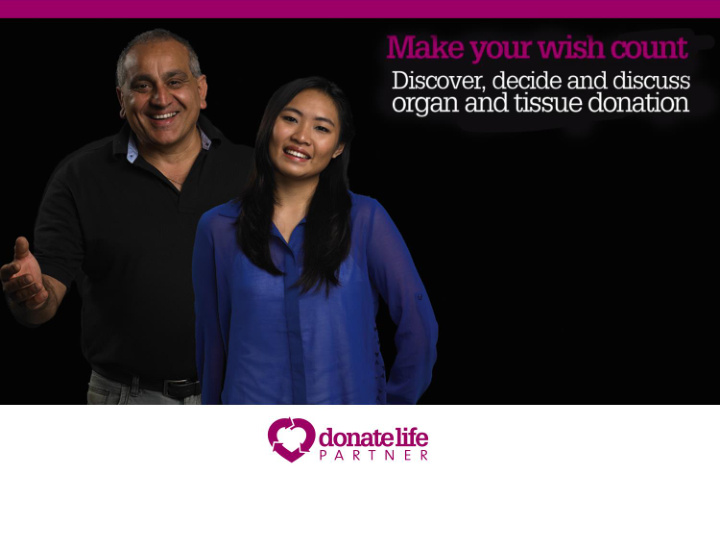



Title of presentation Organ and Tissue Donation Title of presentation Jenny Duggan Communications Officer – 9222 8556 Jennifer.duggan@health.wa.gov.au DonateLife – WA Agency for Organ & Tissue Donation 2
Title of presentation Organ and Tissue Authority (OTA) Title of presentation The OTA is an independent statutory agency within the Australian Government Health portfolio. Established in 2009 and operates under the Australian Organ and Tissue Donation and Transplantation Authority Act 2008, (the Act). Part of the Australian Government's national reform program to improve organ and tissue donation and transplantation outcomes in Australia. 3
Did you know? The majority of Australians (approximately 70%) are willing to become organ and tissue donors. Only 38% of West Australians have registered on AODR. Donation is an infrequent event – Between 1-2% of people in Australia can become an organ donor as particular circumstances must prevail in order for a patient to become medically suitable. In Australia, organ donation does not proceed unless there is a suitable recipient for transplantation. Nine in ten families agree to donation when their loved one is a registered donor. The option to register from your WA Driver’s License application or renewal has not been available in WA since 2004. If you are unable to give blood due to living in the UK during the CJD outbreaks in the 90’s this DOES NOT AFFECT becoming an Organ Donor.
Who can become an organ and tissue donor? Almost anyone can register to donate www.donatelife.gov.au Don’t assume you are too old, too young or not healthy enough People who cannot donate organs may still be able to donate tissue Most religions support organ and tissue donation Living donors can donate a kidney or a partial liver, and for those having a voluntary hip replacement can donate the head of their femur.
In 2017: 510 deceased organ donors gave 1,675 Australians a new chance in life. In Australia more than 60% of families gave consent for organ and tissue donation to proceed.(Aiming for 75% World Best Practice target). Only 38% of Western Australian’s are registered on the AODR. In 2017, there were 1,469 organ transplant procedures performed. The following organs were transplanted: Kidneys (832), Liver (281), Lungs (206), Heart (98), Pancreas (51), Intestines (1)
Australia’s potential deceased organ donor population 2017 Source: 1. 30 June 2014 estimated resident population (ABS 3101.0 Australian Demographic Statistics, Jun 2014. Released 18/12/2014) 1. Estimated from ABS 3302.0 Deaths, Australia, 2013. Released 6/11/2014. 2. Estimated from AIHW Australian hospital statistics 2012-13. Released 30/4/2014. 3. Extrapolated from September 2014 DonateLife Audit Report, Organ and Tissue Authority. 4. ANZOD Monthly Report on Deceased Organ Donation in Australia, January 2015. 7
Donation consent rates
Why do people need transplants? Inherited genetic condition – Cardiomyopathy (affects the heart) – Cystic fibrosis (affects the lungs) – Bilary atresia (affects the liver) Disease or damage to eyes Congenital defects in young children Severe trauma from accidents leading to organ failure Rheumatic fever and other severe illness or disease Burns can require skin grafts
Before Organ Transplant
After
Dane – heart valve recipient DonateLife – Queensland Organ Donation Agency http://www.heart-valve-surgery.com/Images/bicuspid-aortic-valve.gif
Before Organ Transplant
After Organ Transplant Will’s story
Tissue donation enhances quality of life Wayne, corneal recipient DonateLife – Queensland Organ Donation Agency
What a difference a donor makes... A person with a damaged cornea After a corneal transplant
What can people donate? ORGANS TISSUE CORNEAS KIDNEYS HEART VALVES – not in WA LIVER HEART PANCREAS ISLETS SKIN – not in WA LUNGS PANCREAS BONE TENDONS – not in WA LIGAMENTS – not in WA
Tissue Donation Eyes for corneas and sclera (5 – 80yrs) Bones and their associated tissue (15 – 75yrs) Heart valves (not currently retrieved in WA) Skin tissue (not currently retrieved in WA) Exclusions? Risk factors Where? Hospital Theatre / Mortuary When? Up to 24hours after death 18
Who can be a tissue donor? • Live donors – Bone Marrow • Circulatory arrest and brain death • Coronial and non-coronial cases • Primary cerebral tumors • Within 24 hours of circulatory death 19
Tissue Donation Corneas 5 - 100 years Bone Tissue 15 - 65 years Skin Tissue < 70 years Heart Valves < 60 years (> 5kg)
Tissue Storage 30 days Cornea 1 year Sclera 5 years Skin 5 years Bone/ Tendon 5 years Heart Valves
Family support and Follow up • Ongoing support • Follow up letters • Recipient information and assistance in correspondence. • Free counselling • Honour ceremony and other events.
What can you do?
What can you do?
Get involved Ask your friends if they have discussed their donation decision with their next of kin. Organise a speaking event in your community and distribute DonateLife factsheets and resources. Take part in DonateLife Week – 29 July – 5 August 2018 , the annual awareness week Follow DonateLife on social media – Facebook, Instagram and Twitter. Display DonateLife posters and brochures in your community and start a discussion. Discuss with your workplace/sporting organisation about becoming a DonateLife community partner. Take Part in the Writing for Life – micro fiction writing competition grade 7- 12. Launches during DonateLife Week. Take part in Jersey Day – 1 st Friday in September - wear their favourite sporting jersey to school or work.
www.donatelife.gov.au Questions?
Recommend
More recommend